Physical Address
304 North Cardinal St.
Dorchester Center, MA 02124
Many early series recognized that aortic graft infection is difficult to diagnose, is associated with substantial amputation and mortality risks, and has a tendency to recur if inadequately treated. It was recognized early on that inadequately treated aortic graft infection could lead to systemic sepsis or, in propagating to the anastomosis, could lead to pseudoaneurysm and hemorrhage from anastomotic disruption. The 0.2% to 2% incidence of aortic graft infection has remained remarkably constant over the last 4 decades, with an interval between initial graft implantation and symptomatic infection ranging between 41 and 62 months and amputation and mortality rates of 11% and 40%, respectively.
Graft infection may occur at the time of initial surgery because of contamination from skin flora or exposure to bowel organisms through an unrecognized enterotomy during graft tunneling ( Fig. 33-1 ). Other factors associated with the development of aortic graft infection include emergent repairs, lengthy procedures, development of wound complications, or perioperative bacteremia from a urinary tract infection, line sepsis, or pneumonia. Aortofemoral reconstructions are more prone to infection than aortoiliac bypasses, probably because of risk of groin wound necrosis or infection. Although many aortic graft infections can be indolent, others can manifest with protean clinical symptoms of hemorrhage or systemic sepsis.
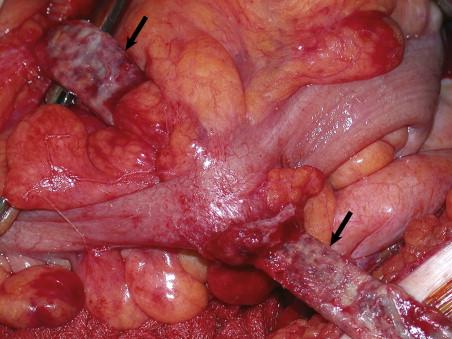
Graft infections have been categorized as early or late based upon time of presentation after implantation. Early aortic graft infections are often associated with more virulent organisms than those presenting late. Most common causative organisms are Staphylococcus, with Staphylococcus aureus often implicated in early infection and coagulase negative Staphylococcus, such as Staphylococcus epidermis, more prevalent in late infections. Enterococcus organisms, gram-negative organisms, fungi, and anaerobes can also be cultured, especially in the presence of graft-enteric erosion. In many aortic graft infections, however, an organism is not identified because of lack of suitable specimens, because of inadequate culture methods, or because antimicrobial coverage was instituted before the collection of tissue for culture.
Early reports demonstrated that simultaneous graft excision and revascularization were associated with very high mortality, so delaying or omitting revascularization was initially advocated to decrease the magnitude of the procedure, even though it was practical for only a minority of patients. Staged extraanatomic arterial reconstruction followed by graft excision was first reported by Elliott and colleagues in 1974. Objections were initially raised to this approach because of concerns related to the presumed risk of bacterial seeding of the new prosthesis, thrombosis of the extraanatomic graft from competitive flow, and risk of interval hemorrhage from the infected graft in the period prior to graft excision. Reilly and associates subsequently demonstrated in a large series that these concerns were unfounded with use of adequate antibiotic coverage and graft removal within 1 week of the initial extraanatomic bypass.
Clinical manifestations. The presentation of aortic graft infection can be variable, and early diagnosis is challenging. Patients with a history of prior aortic graft placement presenting with recurrent fever and chills, pain or pulsatile mass in the abdomen or groin, or evidence of wound infection should be suspected to have aortic graft infection, and those presenting with gastrointestinal hemorrhage, systemic sepsis and shock, or vertebral osteomyelitis usually have advanced infection. The spectrum of gastrointestinal hemorrhage is wide. Suture line fistula can lead to abrupt massive bleeding, whereas graft body erosion into the gastrointestinal tract typically results in low-grade bleeding from the intestinal mucosa. Early presentation of S. aureus or gram-negative infection in the setting of aortoenteric fistula is typically more virulent and can spread rapidly, leading to anastomotic breakdown and exsanguinating hemorrhage. Methicillin-resistant S. aureus has become recognized as a particularly dangerous pathogen because of its destructive characteristics that result in high mortality and risk of limb loss. Indolent, late prosthetic infections may present with limb thrombosis, pseudoaneurysm formation, or fluid collections around poorly incorporated grafts without systemic symptoms and typically involve S. epidermis. This organism secretes a glycoprotein biofilm, which makes its detection difficult unless broth culture and graft sonification are used to isolate the organism. Physical examination may reveal exposed graft material in a contaminated wound or abscess cavity. Graft thrombosis, anastomotic pseudoaneurysm, and septic emboli to the lower extremities are consistent with but not diagnostic of chronic graft infection.
Laboratory findings. Leukocytosis, elevated inflammatory markers, positive blood cultures, and anemia may be present but are nonspecific findings.
Upper gastrointestinal endoscopy. Gastroduodenoscopy to the fourth portion of the duodenum should be performed on patients with a history of aortic graft placement presenting with gastrointestinal bleeding to exclude an aortoenteric fistula. This is demonstrated by exposed graft material if a graft-enteric communication is present ( Fig. 33-2 ).
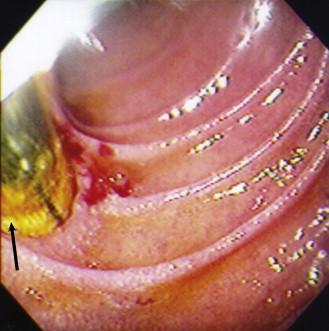
Computed tomography (CT) imaging. CT imaging is the initial diagnostic modality of choice, because it can assess of the extent of graft involvement, as well as provide percutaneous guidance if aspiration of a fluid collection for microbial analysis is required. CT scanning is reported to identify aortic graft infection with a sensitivity of 94% and a specificity of 85%. Characteristic CT findings suggesting the presence of late aortic prosthetic graft infection include periprosthetic gas or fluid, soft tissue thickening, hydronephrosis, vertebral body degeneration, and bowel wall thickening. Although the presence of fluid or loculated air around the graft is common in the early postoperative period after graft implantation, CT demonstration of perigraft gas more than 2 months after aortic reconstruction is suggestive of graft infection ( Fig. 33-3 ).
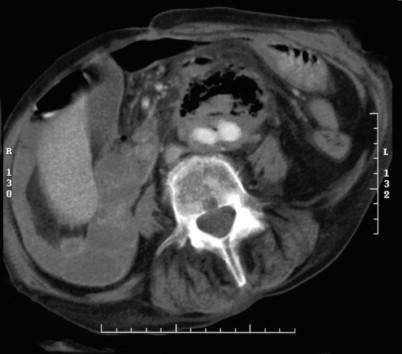
Additional imaging studies. Although radionuclide tagged white cell scanning has been used to identify aortic graft infection, its utility is limited by false-positive results because of uptake in other inflammatory beds. Duplex ultrasonography can identify fluid collections and the presence of a pseudoaneurysm, but its usefulness is limited by bowel gas and body habitus. Magnetic resonance imaging can evaluate inflammatory changes and soft tissue attenuation and can distinguish hematoma from other fluid collections in determining the extent of graft involvement, but it does not add information to that available through a CT scan. Recent studies have suggested that fused fluoro-2-deoxy-d-glucose positron emission tomography (FDG-PET)-CT imaging may improve the diagnostic accuracy of detecting graft infection.
Extent of graft infection. Determination of the extent of graft infection is important to successful treatment planning. If the entire graft is involved, it will likely require removal in its entirety. However, if only one limb of an aortobifemoral graft is involved, it may be possible to remove only the infected portion and salvage the remaining uninfected graft. Complete graft excision is usually required in early infections, because the graft is not incorporated. However, late infections with solitary limb involvement can be treated with limited graft excision if the rest of the graft is well incorporated. Operative inspection of tissue incorporation into the graft and microbial identification can assist in determining the amount of graft that might be salvaged.
Assessment of lower extremity perfusion. Preoperative assessment of lower extremity perfusion is necessary to plan treatment and may be based on physical examination and lower extremity noninvasive studies. If the infected prosthesis is occluded and the lower extremities are viable, excision of the infected graft material alone should be adequate. However, if lower extremity perfusion depends on the involved graft, extraanatomic bypass is required to avoid amputation once the infected graft is removed. CT or conventional arteriography can identify patent vessels available for revascularization of the lower extremities, if required once the infected graft is removed.
Nutritional assessment. Patients with aortic graft infection are often elderly and debilitated, especially if the process is chronic. Adequate nutritional support is critical to meet the metabolic demands of sepsis and a prolonged operative and postoperative course. In the presence of aortoenteric fistula, enteral nutrition may be delayed for a lengthy period. The transition to enteral nutrition may be facilitated by the use of feeding gastrostomy or jejunostomy.
Failure to control hemorrhage. Careful preoperative planning should determine options for proximal and distal arterial control and assess the extent of possible involvement of neighboring venous structures.
Failure to control sepsis. Removal of all infected grossly foreign material is mandatory to minimize the risk of persistent or recurrent infection. Careful management of the aortic stump with an omental flap and oversewn femoral vessels with a sartorius muscle flap after graft removal is a critical component of effective treatment.
Failure of revascularization. Assessment of options for revascularization that bypass the infected field, including the need for an axillofemoral, axilloprofunda, or axillopopliteal bypass, is essential to ensure adequate lower extremity perfusion.
Critical concepts central to the treatment of aortic synthetic graft infection include excision of the infected graft material, debridement of infected tissue, provision of adequate drainage to control local sepsis, revascularization of critical vascular beds, and appropriate antibiotic therapy for primary infection and to prevent secondary infection in the aortic bed, as well as the extraanatomic bypass.
Considerations influencing the choice of reconstruction after the diagnosis of late prosthetic graft infection include the extent of the graft infection, the infecting organism, the dependence of end-organ perfusion on the graft, and the presence of associated patient comorbidities. Because graft material can harbor organisms, which are excluded from the circulation and consequently are not affected by antibiotics delivered in the bloodstream, complete excision of all infected graft material is imperative to control the persisting sepsis. Continuation of appropriate, broad-spectrum antibiotic therapy is necessary to treat the underlying sepsis and prevent bacterial seeding of the new extraanatomic bypass. If the infected graft is patent and the limbs are depending upon the graft for adequate perfusion, then an alternative method of lower extremity perfusion must be provided when the infected graft is removed. Available options include extraanatomic bypass in clean tissue planes or in situ aortoiliac reconstruction. The latter may be performed using a cryopreserved allogeneic homograft or, in an unstable patient, a polytetrafluoroethylene graft or gelatin-impregnated prosthesis soaked in rifampin (45-60 mg/mL) for 15 minutes. Alternatively, in situ reconstruction can use autogenous deep femoral vein to fashion a neoaortoiliac system procedure, as described in the next chapter.
In general, placement of a synthetic graft in a grossly contaminated bed should be avoided because of the risk of recurrent or persistent graft infection, a situation associated with pseudoaneurysm formation and hemorrhage. However, in situ reconstruction with a synthetic Dacron graft soaked in an antibiotic solution, such as rifampin, may be an expeditious option for carefully selected patients with graft infections attributable to organisms of relatively low virulence, such as Staphylococcus epidermidis, in which the infecting organisms are confined to a biofilm on the graft. Important adjuncts to in situ reconstruction include debridement of the aneurysm sac, if present; interposition of healthy tissue, such as omentum around the new prosthesis; and lifelong antibiotic suppression. Extensive synthetic graft infections caused by virulent organisms, such as Pseudomonas aeruginosa, are probably better treated with the complete excision of all infected synthetic material followed by extraanatomic bypass placed in uninvolved tissue planes.
When excision of an infected aortic graft and extraanatomic bypass is planned, the sequence in which the procedures are performed may have important consequences. Several considerations are important when determining the optimal sequence for a particular patient. These include the presence of hemodynamic instability or the potential for rapid decompensation from hemorrhage or sepsis, uncertainty regarding the diagnosis and extent of graft infection, whether lower extremity perfusion depends on the infected graft, and the anticipated duration of the graft excision procedure, especially if additional measures, such as duodenal reconstruction, are likely to be required. Control of hemorrhage is the first priority, but minimizing the duration of lower extremity ischemia while adequately controlling the septic process is necessary for optimal management.
For stable patients in whom the diagnosis and extent of the underlying synthetic graft infection is clear, preliminary extraanatomic bypass is preferable to reduce lower extremity ischemia time. Furthermore, the second stage can sometimes be performed on another day with a fresh team. The theoretical risk of preliminary extraanatomic graft occlusion from competitive flow is usually not a major problem if the interval between stages is minimized. This approach has resulted in substantially higher limb salvage rates compared with simultaneous excision and bypass.
If the patient is hemodynamically unstable, usually from active hemorrhage from an aortoenteric fistula or rupture of an anastomotic pseudoaneurysm and less commonly from overwhelming sepsis, then expeditious exploration with control of the hemorrhage, excision of the infected graft material, and adequate drainage is warranted as the initial procedure. Secondary extraanatomic bypass should be performed in clean surgical fields at the same sitting after reprepping and draping the patient and with a new set of instruments, if the lower extremities are severely ischemic.
The selection of an extraanatomic bypass depends upon the extent of the underlying graft infection, the extent of associated occlusive disease, and the type of aortic reconstruction requiring removal. If the patient has had a prior aortobiiliac graft and the entire graft is involved, then an axillobifemoral graft is the optimal selection to provide lower extremity perfusion ( Fig. 33-4 , A ). The arm with the highest systolic blood pressure should be used for inflow for the extraanatomic bypass, but if both arm blood pressure measurements are equal, the right axillary artery is preferred, because right subclavian artery occlusive disease is less common than left subclavian artery involvement. This configuration also has the advantage of preserving the option to approach the aorta through the left retroperitoneal approach, if needed in the future. However, if the patient has an infected aortobifemoral graft requiring prosthetic removal from both femoral anastomotic sites, then bilateral axillofemoral bypass grafts tunneled through clean tissue planes to the superficial femoral or above-knee popliteal arteries may be necessary ( Fig. 33-4 , B ). Extension to the popliteal artery can usually be accomplished through a lateral subcutaneous tunnel extending across the distal thigh that traverses medially to the popliteal space at a level above the knee. After graft removal, the resulting femoral arteriotomy sites in the groin incisions are closed with an autogenous patch, such as saphenous vein or endarterectomized superficial femoral artery, and if needed are covered with a sartorius muscle flap.
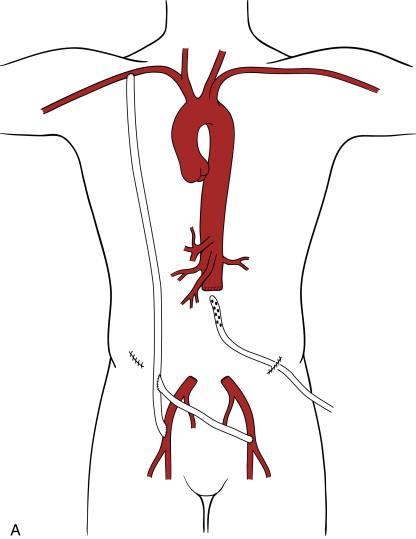
If only a single distal aortobifemoral graft limb is involved with a groin infection but the remaining graft is uninfected, initial division and ligation of the uninvolved proximal limb is performed through a clean retroperitoneal incision. The distal portion of the limb is left in the wound, unless an obturator bypass is considered, and the incision is closed. Limb perfusion is then be restored by constructing an axillosuperficial femoral artery synthetic bypass graft ( Fig. 33-5 , A ). Alternatively, an obturator bypass graft is tunneled medially through the obturator foramen around the infected groin incision through uninvolved tissue planes ( Fig. 33-5 , B ). After closure and placement of occlusive dressings over the extraanatomic bypass incisions, the infected graft material is then removed from the groin and the anastomotic site in the femoral artery is reconstructed using a patch angioplasty with autogenous material.
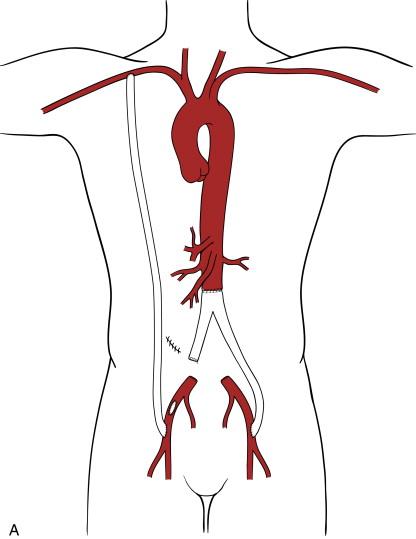
Because the ureters cross anterior to the iliac arteries, they are often adherent to the limbs of a bifurcated synthetic aortic graft in the anatomic tunnel. Consequently, they may be difficult to identify at the time of reoperation, especially in the presence of severe scarring or distortion from the phlegmon, which is often associated with the synthetic graft infection. To avoid ureteral injury or devascularization in this situation, cystoscopic placement of bilateral ureteral stents is indicated.
Become a Clinical Tree membership for Full access and enjoy Unlimited articles
If you are a member. Log in here